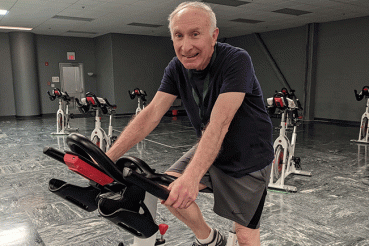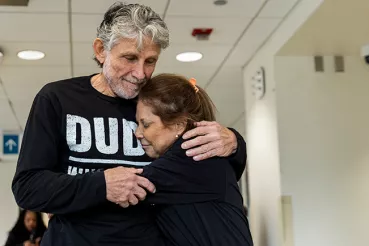An unexpected corporate buyout at her place of employment gave Laura Ashley a golden opportunity to pursue her passions.
No longer burdened with a desk job, Ashley set her sights on a nursing career. At 40, she took charge of her career by working as a nursing assistant in Rush University Medical Center's medical intensive care unit and applied for nursing school.
But then life threw Ashley another curveball — only this time, it wasn't a welcome one. "I started having these episodes: I had trouble breathing and I felt a vice-like tightening in my abdomen," she recalls. "I thought I was having panic attacks."
An unforeseen diagnosis
She promptly visited her doctor, who prescribed anti-anxiety medications. But after a month, the symptoms persisted, and she found herself in the Rush emergency room.
At Rush, doctors determined she had an irregular heartbeat called atrial fibrillation. This diagnosis, though, was just one piece of her puzzle.
About atrial fibrillation
Atrial fibrillation affects at between 2.7 and 6.1 million Americans, according to the American Heart Association. And that number continues to grow as people continue to live longer and with increasing risk factors, says Parik Sharma, MD, MPH, an electrophysiologist at Rush who specializes in treating irregular heart rhythms.
Atrial fibrillation is a chronic condition and requires lifelong care. Left untreated, atrial fibrillation can lead to blood clots and strokes.
Risk factors for atrial fibrillation include the following:
- Advanced age
- High blood pressure
- Underlying heart disease, such as valve problems
- Binge drinking alcohol
- Family history
- Sleep apnea
- Obesity
- High-level athletics
- Chronic conditions such as diabetes
Electrophysiologists at Rush provide comprehensive care for patients with this condition. Care includes the following:
- Discuss lifestyle changes (including diet and exercise)
- Provide resources to help patients modify risk factors
- Prescribe medications and perform procedures to help decrease the burden of atrial fibrillation and minimize the risk of stroke
- Monitor progress of disease condition with regular visits
It was clear that something more was going on. I needed to figure out what was at the root of the problem.
Out-of-control rhythm
Ashley's heart didn't immediately respond to treatment, however. After trying multiple medications, the electrophysiologists at Rush eventually restored Ashley's heart back to a normal rhythm by sending electrical shocks to her heart — a procedure called electrical cardioversion.
After a short hospital stay, Ashley returned home with a plan to manage her newfound condition with medications, diet and exercise, and follow-up visits to Sharma at the clinic.
"But despite aggressive medical therapy with anti-arrhythmic drugs, Laura continued to experience episodes of atrial fibrillation and required multiple cardioversions to help reset her heart back to normal rhythm," Sharma says. "She also developed atrial flutter, a quickened heart beat that's related to atrial fibrillation. It was clear that something more was going on. I needed to figure out what was at the root of the problem."
A startling surprise: Ebstein's anomaly
Admitted to the intensive care unit at Rush, Ashley met interventional cardiologist Clifford Kavinsky, MD, PhD, who ordered further testing. The findings: Not only did Ashley have problems with heart rhythms, she had been born with a faulty heart valve, a rare heart defect called Ebstein's anomaly.
Ashley had never heard of this condition, but here's what she learned about Ebstein's anomaly:
- Causes blood to leak through the faulty valve, making the heart work less efficiently
- Can lead to an enlarged heart or heart failure
- Usually diagnosed in babies, children or teens
- Makes patients more susceptible to atrial fibrillation and atrial flutter
- Requires open-heart surgery to fix the valve
While her weakening condition and the prospect of surgery terrified her, Ashley found strength. "I had made it to 40 living with this condition undiagnosed. Sadly, some people with this condition never get that far," she says. "Surely, there was something keeping me going that could keep me going further."
Coordinated procedures
Before surgery for the Ebstein's anomaly, Sharma had to first get Ashley's irregular heartbeat under control. Together with Ashley, he decided to perform what's known as a hybrid ablation procedure to help better control atrial fibrillation and atrial flutter. Ashley had complete confidence in Sharma. "He was so involved and caring. We just clicked," she says.
Used to treat more challenging and complex heartbeat irregularities, doctors often perform a hybrid ablation: one on the inside of the heart and the other on the outside. For Ashley, these were done in stages.
In the first stage, Sharma performed a catheter-based ablation procedure, which involved advancing catheters through Ashley's leg to inside the surface of her heart using IVs. Energy sources then created scarring, which acted as roadblocks to the abnormal electrical signals that led to the abnormal rhythms.
Given her valve disorder and an associated enlargement of the heart, the ablation procedure was not straightforward, Sharma says. But after a long, challenging ablation procedure, Ashley's heart rhythm stabilized.
After a month, she was ready for surgery to address the Ebstein's anomaly, and Michel Ilbawi, MD, a congenital heart surgeon, repaired the leaky valve she had lived with since birth. During the surgery, she also underwent the second part of the hybrid ablation procedure. This time, Sharma created on the outside of the heart to help control heart rhythm.
Getting back in sync
While the recovery process proved challenging, Ashley is slowly getting her life back in rhythm thanks to lakefront walks, meditation and faith. She recently returned to work and will be visiting the atrial fibrillation clinic regularly. At the clinic, Sharma can help keep her heart rhythm in check and support her as she continues to make lifestyle changes that will help keep her healthy.
She is also looking forward once again to a nursing career, advocating for women's health.
"This experience really inspired me to keep pushing to do what I want to do with my life," she says. "And I now know that I can handle whatever comes my way."




